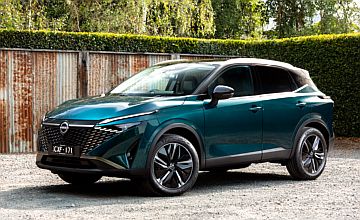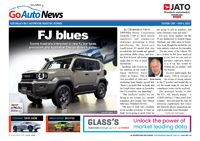Make / Model Search
OptionsCar reviews - Nissan - Qashqai - TiNissan modelsOverviewWe like Easy driving and well-mannered; smooth drivetrain; simple mechanics; comfortable with good quality cabin features; nice 12.3-inch info screen; long warranty Room for improvement Engine/trans gets uncomfortable when pushed; handling is secure but bland; space-saver spare (when there’s room for a full-size wheel) Nissan ups the specification, cabin quality, and tech with a makeover for its Qashqai SUV28 Apr 2025 By NEIL DOWLING Overview
SOMETIMES junior just needs a leg up to get noticed.
Nissan’s evergreen X-Trail remains the stalwart of the brand with sales about 2000 a month, more than twice that of the Navara ute, while its other SUVs are being overlooked.
Enter a new look and higher spec plus price adjustments for the smallest SUV, the Qashqai.
Smallest shouldn’t imply claustrophobic cabin dimensions and a footprint that could easily get walked on by bigger wagons. In fact, the Qashqai, at 4400mm long, is the perfect size for a couple of adults, perhaps those seeking retirement without any desire to tour Australia ahead of a caravan.
For 2025, the SUV gets a design makeover that is neither necessary nor particularly beneficial. But the inclusion of the head turning waterfall grille with its complex layers of plastic kinks does certainly add to the aesthetics – and in a market with a host of similar sized SUVs from many countries (but mainly one), that’s important.
Tested here is the Ti variant, with the longstanding 1.3-litre turbo-petrol engine. Together with the better cabin tech – it gets things like Nissan’s new connected car service plus a 12.3-inch TFT screen for the cabin – and well-priced $42,965 (plus costs) sticker, it has a lot of appeal… and that’s before pressing the starter button.
Unless you particularly want a bigger SUV and have more urban duties in mind, put the junior Nissan on your shopping list.
Driving Impressions
Few motorists who enjoy driving have much empathy for continuously variable transmissions (CVTs). Basically, a band running between two cones, CVTs aren’t particularly responsive, give a strange ‘elastic’ feel to the drive and never give the driver the impression that there’s much going on under the bonnet.
But they are simple, comparatively light, relatively inexpensive, offer a smooth and seamless drive feel, and most importantly, cleverly engage at the engine’s point of peak efficiency to maximise fuel economy.
If you don’t drive the CVT-equipped vehicle like you stole it, they also tend to be reliable. Push hard over a long period of time and they tend to disintegrate, hence the market for a CVT car is a docile owner with a conservative route.
Precisely an environment made for the Nissan Qashqai (and X-Trail, Pathfinder, and Juke and, of course dozens of models from other brands).
It is a sweet ride and driven properly, any potential issues with the CVT become invisible.
The engine is a turbocharged 1.3-litre four-cylinder (HR13DDT) with 110kW/250Nm and featuring bore-spray coating for durability and low friction (also used on the GT-R).
It also appears in slight power and features in some Mercedes-Benz models as the M282 engine, and in some Renaults and Dacias, as early as 2018.
Much of the engine's performance is tied to the CVT but there’s no doubting that the engine is smooth and has adequate power for the Qashqai’s 1472kg weight and its urban-focused duty.
It’s also quiet and responsive, will tour easily at 100km/h at around 2000rpm and this relaxed drivetrain is complemented by the cushy ride while cruising. It makes for a surprisingly capable and tireless country car.
The Qashqai isn’t designed as a sporty wagon, but it has good grip (it’s only available in Australia as a front-wheel drive) through the corners and predictable handling over irregular roads.
The steering is light – which most target buyers will appreciate, especially city dwellers – which takes a bit of familiarisation on winding country roads. That said, the handling is accurate and except for the light steering feel, communicative so it inspires confidence.
All the chassis features – brakes, dampers, tyre selection (19-inch on the Ti), and so on – feel equally as capable.
Relaying all this back to the driver is via a restyled dashboard with more drive information and a bigger 12.3-inch central screen.
These are new additions for 2025 and come on top of the Qashqai’s ongoing pleasantries such as the good side and forward visibility (there’s a camera for the rear), plenty of foot room for pedal control, comfortable access and egress from all seats, and ergonomics that give the driver easy access to all controls.
Cabin room is surprisingly good for the compact external dimensions. The Qashqai sells into the small SUV sector, yet it belies its classification by seating four adults or two kids (one in a baby seat) in the rear.
Four adults are comfortable without banging elbows and with sufficient leg and head room. Consider how often you need to carry four adults, and the Qashqai may fit the bill, rather than moving up to, say, an X-Trail.
The boot offers a decent 479 litres (seats up) or 1422 litres (rear seat folded). It is well suited to a couple, perhaps one with two small kids but maybe a bit tight with paraphernalia such as pram, collapsed cot and baby luggage.
The 2025 Qashqai range adds more equipment and dresses the cabin in more upmarket materials and patterns.
The use of the patterns and the plusher materials makes a stronger impression to the cabin and particularly the dashboard. Nissan has used these decorative features along with the addition of Alcantara on the Ti’s dash, door cards and centre console to succeed in raising the appearance of prestige.
There is ambient lighting added to the interior and externally, the option of a black roof.
Paint colours have been changed, including richer tones and the addition of an impressive dark green-blue metallic dubbed Deep Ocean.
All Qashqai versions now get a tech upgrade, starting with the entry-level’s ST that has a 12.3-inch screen with wireless Apple CarPlay and Android Auto.
New for 2025 is the ability to download the Nissan Car Connected Services (CCS) app that allows access to the vehicle functions and to health and status information, trip history and theft and tow alerts.
The Ti also adds a heated steering wheel to complement the heated seats and part-leather seat upholstery.
Nissan has a (currently) unbeatable 10-year / 300,000km warranty together with a 10-year roadside assistance program – both conditional to the car being serviced at a Nissan dealership.
It also has a five-year ‘flat price’ service program that is very well priced.
The car needs to be serviced once a year. For the Qashqai (petrol and hybrid) the price is $399 a year, so $1995 for the five-year program.  Read more17th of February 2025  N-Design grade joins updated Nissan QashqaiDesign, connectivity improvements for revamped 2025 Nissan Qashqai rangeAll car reviews Alfa Romeo Alfa Romeo Abarth Abarth Audi Audi Aston Martin Aston Martin BMW BMW Bentley Bentley Chrysler Chrysler Chevrolet Chevrolet Dodge Dodge Citroen Citroen Ferrari Ferrari DS DS Ford Ford Fiat Fiat FPV FPV Foton Foton Haval Haval Great Wall Great Wall Honda Honda Holden Holden Hyundai Hyundai HSV HSV Isuzu Isuzu Infiniti Infiniti Jaguar Jaguar Iveco Iveco Kia Kia Jeep Jeep Land Rover Land Rover Lamborghini Lamborghini Maserati Maserati Lexus Lexus McLaren McLaren Mazda Mazda Mercedes-Benz Mercedes-Benz Mitsubishi Mitsubishi Mini Mini Opel Opel Nissan Nissan Porsche Porsche Peugeot Peugeot Ram Ram Proton Proton Rolls-Royce Rolls-Royce Renault Renault Skoda Skoda Saab Saab SsangYong SsangYong Smart Smart Suzuki Suzuki Subaru Subaru Toyota Toyota Tesla Tesla Volvo Volvo |
OptionsClick to share
|











Facebook Twitter Instagram